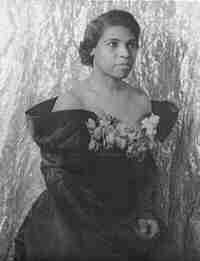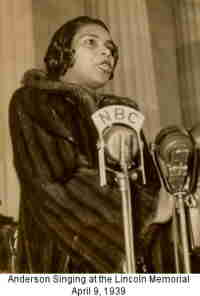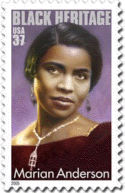 SKC Films Library SKC Films Library |
| SKC Films Library >> Musics >> Biography: Singers |
 Marian Anderson Marian Andersonthe first African-American to sing a major role on the New York Metropolitan Opera stage Marian Anderson was born in South Philadelphia, Pennsylvania, on February 27, 1887. Her father was an ice and coal salesman, and her mother was a former teacher. Her father died when she was a child, and her mother worked as a cleaning woman and laundress to support the family. Marian began singing in the Union Baptist Church Choir at the age of six. When she was ten, the church members gave a benefit concert to raise money for her to take private singing lessons. The concert was successful, but she was denied admission to a local music school because she was black. Fortunately, she was able to find a teacher who gave her lessons for free. When Marian was nineteen, she began studying with Giuseppe Boghetti. In 1925, he helped her enter a contest in which she competed with 300 singers for the Lewisohn Stadium Concert Award for a chance to perform with the New York Philharmonic Orchestra. She won the contest and sang with the Orchestra on August 26, 1925. After performing with the Orchestra, Anderson received a Rosenwald Foundation Fellowship and had the opportunity to study in London. Between 1925 and 1935, Anderson performed extensively in Europe, including an appearance during the 1935 Mozart Festival in Austria and a performance before the Archbishop of Salzburg. Composer Jean Sibelius even dedicated the song "Solitude" to her. Returning to the United States in 1935, Anderson soon became the country's third highest concert box office draw. Her successes, however, did not lessen the racial discrimination she encountered on a regular basis.
In 1954, Anderson was signed for the role of Ulrica in the Metropolitan Opera's production of Un Ballo in Maschera (The Masked Ball), by Giuseppe Verdi. On January 7, 1955, she became the first African-American to sing a major role on the Met stage. In 1956, Anderson made a farewell tour throughout the United States and Europe. In 1957, she toured twelve Asian nations on behalf of the U.S. State Department. In 1958, she was named to the U.S. delegation to the United Nations. She gave her final concert in Philadelphia, in 1965, and then settled with her husband, Orpheus Fisher, on a farm in Connecticut; she later moved into the Portland, Oregon, home of her nephew, James De Priest. She made her last public appearance at the dedication of St. Christopher's Hospital for Children's pediatric sickle-cell anemia clinic and research center, which was named in her honor, in 1991.
Anderson received a number of honors
and awards throughout her life and career, including: SOURCE SEE ALSO |
| SKC Films Library >> Musics >> Biography: Singers This page was last updated on 06/05/2017. |
 In 1939, officials from Howard University tried
to arrange a concert for her in Constitution Hall, the
largest and finest indoor location in Washington, D.C.
The hall's owners, the Daughters of the American
Revolution, refused to allow an African-American to
perform there, however, and sparked a wave of protests
across the country.
In 1939, officials from Howard University tried
to arrange a concert for her in Constitution Hall, the
largest and finest indoor location in Washington, D.C.
The hall's owners, the Daughters of the American
Revolution, refused to allow an African-American to
perform there, however, and sparked a wave of protests
across the country.  Marian
Anderson died on April 8, 1993. In June, over 2,000
admirers attended a memorial service held in her honor at
Carnegie Hall in New York. In 2005, she was honored by
the United States Postal Service on its 28th stamp in the
Black Heritage Series.
Marian
Anderson died on April 8, 1993. In June, over 2,000
admirers attended a memorial service held in her honor at
Carnegie Hall in New York. In 2005, she was honored by
the United States Postal Service on its 28th stamp in the
Black Heritage Series.